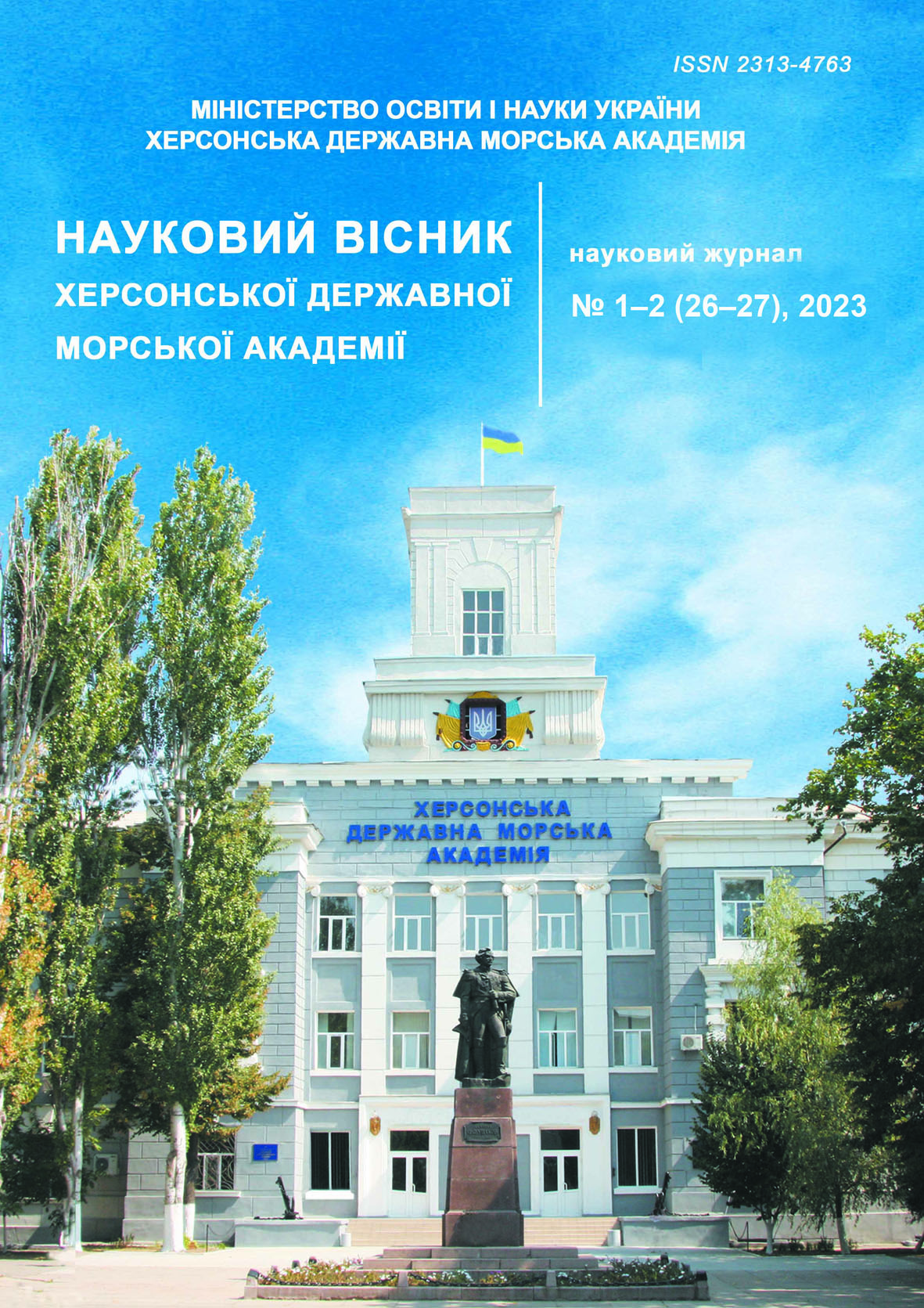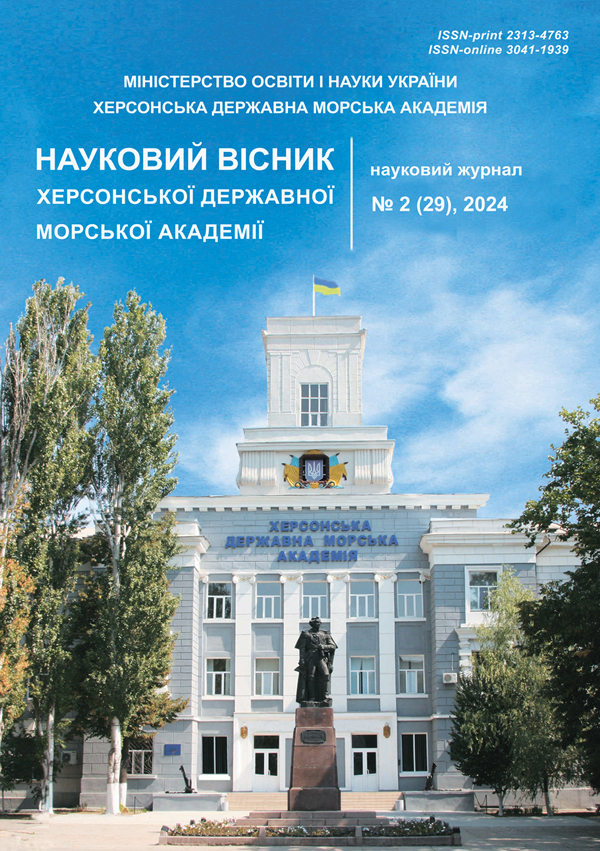DEVELOPMENT OF METHODS AND MEANS FOR AUTOMATING ONBOARD NAVIGATION CALCULATIONS IN CRITICAL SITUATIONS
https://doi.org/10.33815/2313-4763.2024.2.29.122-138
Abstract
The research developed a comprehensive approach to improve the reliability of marine navigation systems in situation of electronic navigation equipment failures, cyber-attacks and blackout conditions. Innovative algorithmic solutions are proposed to ensure a rapid transition from digital navigation technologies to alternative systems based on the methods of marine astronomy and principles of the Dead Reckoning ECDIS method.
The software tool has been created for the automated calculation of vessel coordinates using a sextan. This tool takes corrections into account, methods of statistical processing of data series, automatically detects misses and determines average values with a minimum total error. Determination of observed coordinates is implemented based on mathematical models of altitude lines of position taking into account course, speed and time between observations.
In addition, an autonomous electronic mapping system based on Python libraries (folium, geopy, ipywidgets) has been developed, which provides interactive input of route points coordinates, construction of route segments, calculation of vessel's speed and course, as well as visualization of results on interactive maps. The system can function locally without access to the Internet due to the use of web-oriented map data, which ensures stability and reliability of observation even in extreme conditions.
Experimental testing has confirmed high accuracy of calculations and effectiveness of proposed solutions in situations of electronic navigation system failures. In case of blackout, the developed system allows to restore navigation functions and ensure vessel’s safety.
The practical value of the work is to create a flexible, reliable navigation system that minimizes risks in case of technical failures or targeted cyberattacks. Prospects for further research include improving algorithms to reduce errors and adapting the system to real-world operating conditions on vessels in any navigation conditions.
References
2. Vilskyi, H. B., & Nadych, M. M. (2011). Modeliuvannia informatsiinoi bezpeky sudna. Visnyk Vinnytskoho politekhnichnoho instytutu, (4), 149–153.
3. Melnyk, O. M., Shcherbyna, O. V., Koriakin, K. S., & Burlachenko, D. A. (2022). Ohliad ta perspektyvy vykorystannia suchasnykh system kursovkazannia na morskykh sudnakh dlia zabezpechennia navihatsiinoi bezpeky. Sudnovodinnia. 21(1), 13–22. https://doi.org/ 10.33216/2222-3428-2021-21-13.
4. Daki, O. A., Urum, N. S., Fedunov, V. M., & Bazhak, O. V. (2021). Metody morekhidnoi astronomii v suchasnosti. Systemy upravlinnia, navihatsii ta zviazku, 3(65), 24–29. https://doi.org/10.26906/SUNZ.2021.3.024.
5. Maranov, O. V. (2023). Prohnozuvannia vidmov sudnovykh navihatsiinykh system z vykorystanniam metodiv mashynnoho navchannia. Systemy upravlinnia, navihatsii ta zviazku, 3(65), 37–46. https://doi.org/10.26906/SUNZ.2023.3.037.
6. Melnyk, O. M., Onyshchenko, S. P., Lohinov, O. V., Okulov, V. I., & Puliaiev, I. O. (2021). Aktualni problemy morskoi bezpeky ta suchasni shliakhy zabezpechennia okhorony sudna. Komunalne hospodarstvo mist, 6(166), 204–210. https://doi.org/10.33042/2522-1809-2021-6-166-204-210.
7. Maranov, O. V. (2023). Metod monitorynhu ta pidvyshchennia kharakterystyk tochnosti sudnovoho suputnykovoho navihatsiinoho obladnannia. Visnyk Pryazovskoho derzhavnoho tekhnichnoho universytetu. Seriia: Tekhnichni nauky, 46, 158–165. https://doi.org/10.31498/2225-6733.46.2023.288185.
8. Nguyen, T. D. (2020). Applying the least square method to calculate the non-simultaneous errors of ship’s position determined by global positioning system (GPS). Journal of Physics: Conference Series, 1679, 052015. https://doi.org/10.1088/1742-6596/1679/5/052015.
9. DNV (2024). Managing the Risks of Blackout for Passenger Ship Owners and Operators. DNV Guidance Paper. https://www.dnv.com.
10. Yakusevych, Yu. H., Tryshyn, V. V., & Dorofieieva, Z. Ya. (2021). Pobudova navihatsiinoi systemy sudna na osnovi suchasnykh informatsiinykh tekhnolohii. Zbirnyk naukovykh prats Kharkivskoho natsionalnoho universytetu Povitrianykh Syl, 4(70), 83–92. https://doi.org/10.30748 /zhups.2021.70.12.
11. Utomo, M. N. S., Wiweko, A., Siregar, M. S., David, M., & Nurmala, E. (2024). The Role of Emergency Generator during Black-Out on the MV. Kelud. Jurnal Transportasi dan Bahari, 1(1), 9–20. https://jurnal.atriastar.com/index.php/altair.
12. Kalinichenko, Y., Tomchakovsky, G., Adamchuk, M., Koliesnik, O., & Khlebnikov, S. (2023). GeoGebra for navigational purposes. Proceedings of the XIX International Scientific and Practical Conference, Tokyo, Japan, 389–392. Retrieved from https://isg-konf.com/innovative-approaches-to-solving-scientific-problems/.
13. Kalinichenko, Y., Adamchuk, M., Tomchakovsky, G., Koliesnik, O., & Oberto Santana, L. (2023). GeoGebra for navigation purposes: Theory and application. Innovative Approaches to Solving Scientific Problems. https://doi.org/10.52058/2786-6025-2023-7(21)-230-243.
14. Kalinichenko, Ye., Tomchakovskyi, H., Prykhodko, V., Oberto Santana, L., & Pichkov, V. (2023). Zastosuvannia metodu "Dead Reckoning" dlia zabezpechennia roboty EKNIS pry vidmovi sudnovoi stantsii GPS. Tekhnichni nauky: Innovatsiini naukovi doslidzhennia: teoriia ta praktyka, 490–493. Retrieved from https://radionavlab.ae.utexas.edu/images/stories/files/ papers/yacht.pdf.
15. Zbirnyk zadach z morekhidnoi astronomii (2002). / red. V. A. Seniaieva. Odesa, 184 s.
16. Tsai, K.-C., Tseng, W.-K., Chen, C.-L., & Sun, Y.-J. (2022). A Novel Analytical Solution Method for Celestial Positioning. Journal of Marine Science and Engineering, 10(6), 771. https://doi.org/10.3390/jmse10060771.
17. Wakita, K., Hane, F., Sekiguchi, T., Shimizu, S., Mitani, S., Akimoto, Y., & Maki, A. (2024). Conceptual design on the field of view of celestial navigation systems for maritime autonomous surface ships. arXiv preprint arXiv:2408.15765. https://arxiv.org/abs/2408.15765.






